-
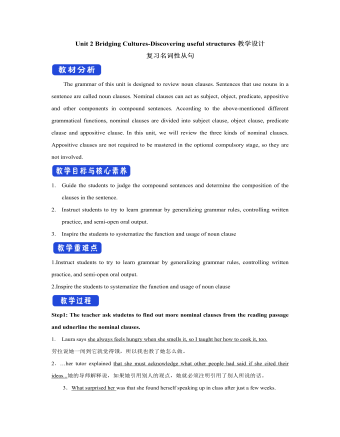
新人教版高中英语选修2Unit 2 Bridging Cultures-Discovering useful structures教学设计
The grammar of this unit is designed to review noun clauses. Sentences that use nouns in a sentence are called noun clauses. Nominal clauses can act as subject, object, predicate, appositive and other components in compound sentences. According to the above-mentioned different grammatical functions, nominal clauses are divided into subject clause, object clause, predicate clause and appositive clause. In this unit, we will review the three kinds of nominal clauses. Appositive clauses are not required to be mastered in the optional compulsory stage, so they are not involved.1. Guide the students to judge the compound sentences and determine the composition of the clauses in the sentence.2. Instruct students to try to learn grammar by generalizing grammar rules, controlling written practice, and semi-open oral output.3. Inspire the students to systematize the function and usage of noun clause1.Instruct students to try to learn grammar by generalizing grammar rules, controlling written practice, and semi-open oral output.2.Inspire the students to systematize the function and usage of noun clauseStep1: The teacher ask studetns to find out more nominal clauses from the reading passage and udnerline the nominal clauses.
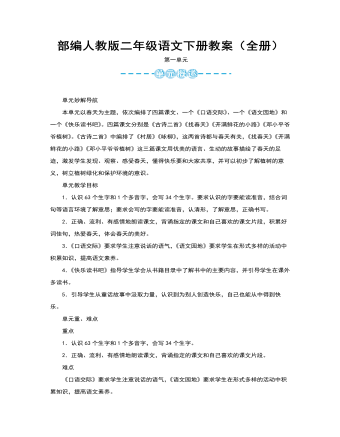
二年级语文下册教案课程全册
本文是一篇语言优美,充满儿童情趣和文学色彩的文章,仿佛呼唤着我们去寻找春天。我们到校园里找一找,也许能在操场边发现刚探出头的小草;我们到野外去找一找,也许能在天空中发现飘飘摇摇的风筝;打开课本,我们还会在课本插图中发现春天的影子;读着课文,我们会感觉自己就是那几个脱掉棉袄,冲出家门,奔向田野的孩子,我们还能体会到寻找春天的急切心情,感受到发现春天的欣喜。二年级学生具有好奇、爱探索、易受感染的心理特点,容易被新鲜的事物、活动的东西所吸引。在一年半的语文学习后,他们已经能够说一段较完整的话,并能在教师创设的情境中体验、感受,达到情感的共鸣,同时也积累了不少生活素材,这些都是学习本课的有利因素。
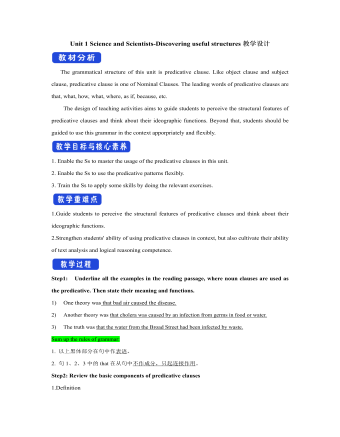
新人教版高中英语选修2Unit 1 Science and Scientists-Discovering useful structures教学设计
The grammatical structure of this unit is predicative clause. Like object clause and subject clause, predicative clause is one of Nominal Clauses. The leading words of predicative clauses are that, what, how, what, where, as if, because, etc.The design of teaching activities aims to guide students to perceive the structural features of predicative clauses and think about their ideographic functions. Beyond that, students should be guided to use this grammar in the context apporpriately and flexibly.1. Enable the Ss to master the usage of the predicative clauses in this unit.2. Enable the Ss to use the predicative patterns flexibly.3. Train the Ss to apply some skills by doing the relevant exercises.1.Guide students to perceive the structural features of predicative clauses and think about their ideographic functions.2.Strengthen students' ability of using predicative clauses in context, but also cultivate their ability of text analysis and logical reasoning competence.Step1: Underline all the examples in the reading passage, where noun clauses are used as the predicative. Then state their meaning and functions.1) One theory was that bad air caused the disease.2) Another theory was that cholera was caused by an infection from germs in food or water.3) The truth was that the water from the Broad Street had been infected by waste.Sum up the rules of grammar:1. 以上黑体部分在句中作表语。2. 句1、2、3中的that在从句中不作成分,只起连接作用。 Step2: Review the basic components of predicative clauses1.Definition
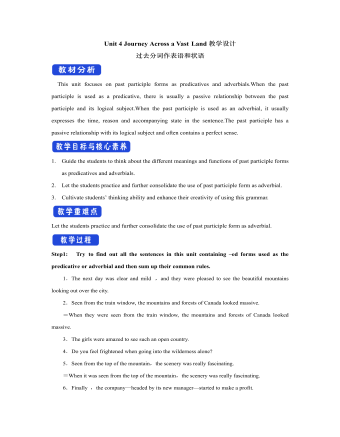
新人教版高中英语选修2Unit 4 Journey Across a Vast Land教学设计
当孩子们由父母陪同时,他们才被允许进入这个运动场。3.过去分词(短语)作状语时的几种特殊情况(1)过去分词(短语)在句中作时间、条件、原因、让步状语时,相当于对应的时间、条件、原因及让步状语从句。Seen from the top of the mountain (=When it is seen from the top of the mountain), the whole town looks more beautiful.从山顶上看,整个城市看起来更美了。Given ten more minutes (=If we are given ten more minutes), we will finish the work perfectly.如果多给十分钟,我们会完美地完成这项工作。Greatly touched by his words (=Because she was greatly touched by his words), she was full of tears.由于被他的话深深地感动,她满眼泪花。Warned of the storm (=Though they were warned of the storm), the farmers were still working on the farm.尽管被警告了风暴的到来,但农民们仍在农场干活。(2)过去分词(短语)在句中作伴随、方式等状语时,可改为句子的并列谓语或改为并列分句。The teacher came into the room, followed by two students (=and was followed by two students).后面跟着两个学生,老师走进了房间。He spent the whole afternoon, accompanied by his mom(=and was accompanied by his mom).他由母亲陪着度过了一整个下午。
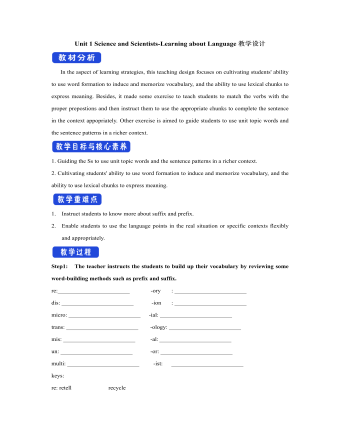
新人教版高中英语选修2Unit 1 Science and Scientists-Learning about Language教学设计
Step 7: complete the discourse according to the grammar rules.Cholera used to be one of the most 1.__________ (fear) diseases in the world. In the early 19th century, _2_________ an outbreak of cholera hit Europe, millions of people died. But neither its cause, 3__________ its cure was understood. A British doctor, John Snow, wanted to solve the problem and he knew that cholera would not be controlled _4_________ its cause was found. In general, there were two contradictory theories 5 __________ explained how cholera spread. The first suggested that bad air caused the disease. The second was that cholera was caused by an _6_________(infect) from germs in food or water. John Snow thought that the second theory was correct but he needed proof. So when another outbreak of cholera hit London in 1854, he began to investigate. Later, with all the evidence he _7_________ (gather), John Snow was able to announce that the pump water carried cholera germs. Therefore, he had the handle of the pump _8_________ (remove) so that it couldn't be used. Through his intervention,the disease was stopped in its tracks. What is more, John Snow found that some companies sold water from the River Thames that __9__________________ (pollute) by raw waste. The people who drank this water were much more likely _10_________ (get) cholera than those who drank pure or boiled water. Through John Snow's efforts, the _11_________ (threaten) of cholera around the world saw a substantial increase. Keys: 1.feared 2.when 3. nor 4.unless 5.that/which 6.infection 7.had gathered 8.removed 9.was polluted 10.to get 11. threat
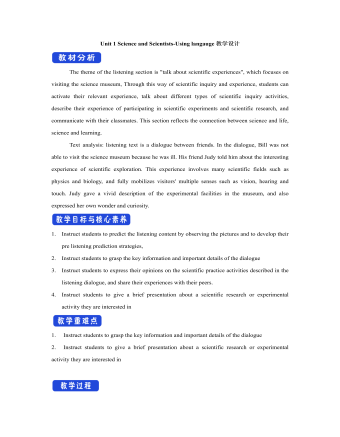
新人教版高中英语选修2Unit 1 Science and Scientists-Using langauge教学设计
This happens because the dish soap molecules have a strong negative charge, and the milk molecules have a strong positive charge. Like magnets, these molecules are attracted to each other, and so they appear to move around on the plate, taking the food coloring with them, making it look like the colors are quickly moving to escape from the soap.Listening text:? Judy: Oh, I'm so sorry that you were ill and couldn't come with us on our field trip. How are you feeling now? Better?? Bill: Much better, thanks. But how was it?? Judy: Wonderful! I especially liked an area of the museum called Light Games.it was really cool. They had a hall of mirrors where I could see myself reflected thousands of times!? Bill: A hall of mirrors can be a lot of fun. What else did they have?? Judy: Well, they had an experiment where we looked at a blue screen for a while, and then suddenly we could see tiny bright lights moving around on it. You'll never guess what those bright lights were!? Bill: Come on, tell me!? Judy: They were our own blood cells. For some reason, our eyes play tricks on us when we look at a blue screen, and we can see our own blood cells moving around like little lights! But there was another thing I liked better. I stood in front of a white light, and it cast different shadows of me in every color of the rainbow!? Bill: Oh, I wish I had been there. Tell me more!? Judy: Well, they had another area for sound. They had a giant piano keyboard that you could use your feet to play. But then, instead of playing the sounds of a piano, it played the voices of classical singers! Then they had a giant dish, and when you spoke into it, it reflected the sound back and made it louder. You could use it to speak in a whisper to someone 17 meters away.? Bill: It all sounds so cool. I wish I could have gone with you? Judy: I know, but we can go together this weekend. I'd love to go there again!? Bill: That sounds like a great idea!
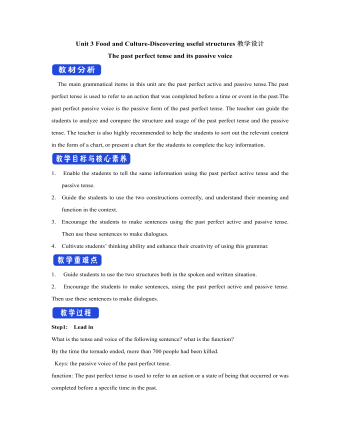
新人教版高中英语选修2Unit 3 Food and Culture-Discovering useful structures教学设计
The newspaper reported more than 100 people had been killed in the thunderstorm.报纸报道说有一百多人在暴风雨中丧生。(2)before、when、by the time、until、after、once等引导的时间状语从句的谓语是一般过去时,以及by、before后面接过去的时间时,主句动作发生在从句的动作或过去的时间之前且表示被动时,要用过去完成时的被动语态。By the time my brother was 10, he had been sent to Italy.我弟弟10岁前就已经被送到意大利了。Tons of rice had been produced by the end of last month. 到上月底已生产了好几吨大米。(3) It was the first/second/last ... time that ...句中that引导的定语从句中,主语与谓语构成被动关系时,要用过去完成时的被动语态。It was the first time that I had seen the night fact to face in one and a half years. 这是我一年半以来第一次亲眼目睹夜晚的景色。(4)在虚拟语气中,条件句表示与过去事实相反,且主语与谓语构成被动关系时,要用过去完成时的被动语态。If I had been instructed by him earlier, I would have finished the task.如果我早一点得到他的指示,我早就完成这项任务了。If I had hurried, I wouldn't have missed the train.如果我快点的话,我就不会误了火车。If you had been at the party, you would have met him. 如果你去了晚会,你就会见到他的。
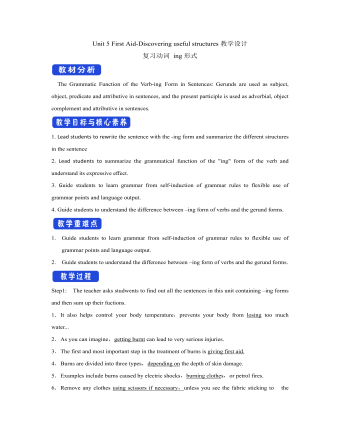
新人教版高中英语选修2Unit 5 First Aid-Discovering useful structures教学设计
You have no excuse for not going.你没有理由不去。He was punished for not having finished his homework.他因未完成作业而受到惩罚。2.动词ing形式复合结构由物主代词或人称代词宾格、名词所有格或普通格加动词ing,即“sb./sb.'s+doing”构成。动词ing形式的复合结构实际上是给动词ing形式加了一个逻辑主语。动词ing形式的复合结构有四种形式:①形容词性物主代词+动词ing②名词所有格+动词ing③代词宾格+动词ing④名词+动词ingHer coming to help encouraged all of us.她来帮忙鼓舞了我们所有人。The baby was made awake by the door suddenly shutting.这个婴儿被突然的关门声吵醒了。Can you imagine him/Jack cooking at home?你能想象他/杰克在家做饭的样子吗?无生命名词无论是作主语还是作宾语都不能用第②种形式。Tom's winning first prize last year impressed me a lot.汤姆去年得了一等奖使我印象深刻。Do you mind my/me/Jack's/Jack leaving now?你介意我/杰克现在离开吗?Excuse me for my not coming on time.很抱歉我没能按时来。His father's being ill made him worried.他父亲病了,他很担心。We are looking forward to the singer's/the singer to give us a concert.我们盼望着这位歌手来给我们举办一场演唱会。
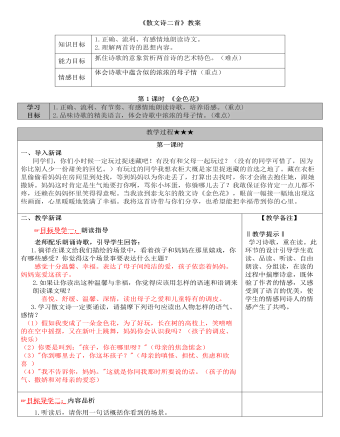
部编版语文七年级上册《散文诗二首》教案
?目标导学三:拓展延伸 1.请你模仿例句仿写。例句:母亲啊!你是荷叶,我是红莲,心中的雨点来了,除了你,谁是我在无遮拦天空下的荫蔽? 仿写: 示例一 :母亲啊,你是流水,我是鱼儿,当干旱来临时,除了你,谁还能为我提供一个安定的家?示例二:母亲啊,你是避风港,我是小船,狂风暴雨来临时,除了你,谁是我在无遮拦大海中的依靠? 示例三:母亲啊,你是鸟巢,我是小鸟,心中的寒冷来了,除了你,谁是我在冷风中的温暖? 2. 人说:天下的母亲有着不一样的面容,但唯有一样——母爱,是完全一样的。同学们,我们享受母爱十余载,那么你们的母亲是如何保护、关爱你们的呢?

部编人教版四年级下册《文言文二则》教案
一、谈话交流,导入课题。1.同学们,《凿壁偷光》的故事大家听说过吗?【课件出示2:图文】匡衡勤奋好学,可是家境贫寒,晚上想读书而无烛照明。邻居家倒是每到夜晚,总烛光明亮,可惜这光照不到他匡衡的屋里。怎么办呢?匡衡便把自己家靠邻舍的那堵墙壁凿开一个洞以引邻居家的烛光来读书。古时候,还有一位热爱读书的人,他是晋代车胤,因为家贫,没钱买灯油,而又想晚上读书,便在夏天晚上抓一把萤火虫来当灯读书。2.这个故事就是《囊萤夜读》,今天,我们来学习一下这个小故事。(板书:囊萤夜读)学生齐读课题。3.这是一篇文言文。千古传诵,流传至今。4.补充文言文知识:文言文人们通常说古文。我国是一个文明古国,我国古代有着灿烂的文化,有着浩如烟海的文学艺术瑰宝,他们都是以文言文的形式记载下来的。我们要去传承民族的瑰宝,就要学好文言文。【课件出示3】
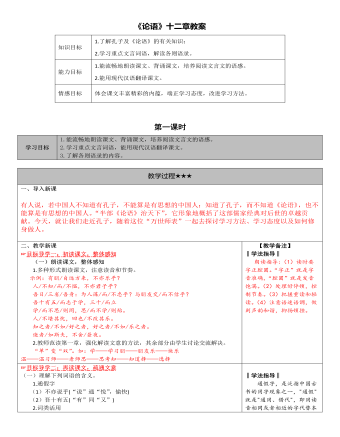
部编版语文七年级上册《论语》十二章教案
2.在新知与旧知、知识与实践的关系上,在学与思、学与问的关系上,孔子是怎么看的?新知与旧知的关系上,孔子认为“温故”可以“知新”。也只有“温故”“知新”的人才能当老师。这里,孔子强调的是“新知”,是那种开拓、创新的精神。在知识与实践的关系上,孔子认为“学而时习之”。学了知识要按时去实习,把所学的东西运用到行动上,在实践中提高对知识的掌握程度。在学与思的关系上,孔子认为学习与思考必须结合,二者缺一不可。只读书而不通过自己的头脑加以思考,就会感到迷惑;只是一味空想而不读书,就会精神疲惫。在学与问的关系上,孔子主张既学又问,不仅问知识才能比自己高的人,即使是知识才能比自己低的人,只要他们在某一方面有一技之长、一得之见,就应该虚心向他们求教,不以为羞耻。
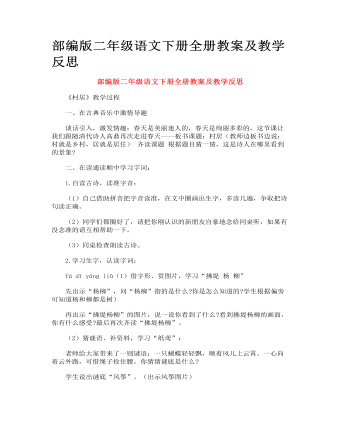
部编版二年级语文下册全册教案及教学反思
在入情入境中诵读成韵 1.配乐范读,想象画面: (1)学生边看插图边听老师配乐朗读,想象诗中所描绘的画面。 (2)学生自由交流想象中的画面,老师激励小结。 预设:山坡上的小草发芽了,嫩绿嫩绿的。黄莺在空中飞来飞去。河堤旁的柳条发芽了,几个下朋友放学回来,趁着东风,赶忙放起了风筝…… 2.借助插图,启发想象:黄莺一边飞一边干什么?(叽叽喳喳地叫)它好像在说什么? 再次启发想象:春风轻轻地吹来,柳条会怎样呢?(轻轻摆动,好像在跳舞陶醉在了美丽的春色里……) 诗人高鼎看到这样的景致写下了这样的诗句:出示“草长莺飞二月天,拂堤杨柳醉春烟”。(学生齐读) 让我们想象着春天的美丽景色,有滋有味地诵读。学生练读、指名读、引读。 3.联系生活,换位体验,:在这样美妙的春光里,沐浴着和煦的春风,(出示儿童放纸鸢图片)孩子们放起风筝,你们放过风筝吗?你放风筝时是怎样的心情?(学生自由发言)
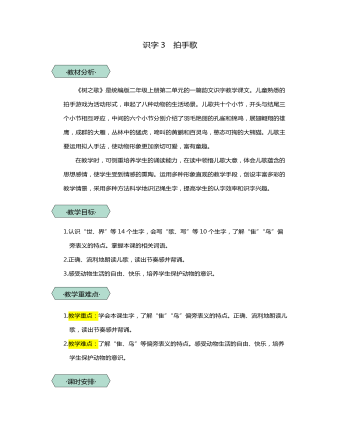
统编版二年级语文上识字3拍手歌教案
《树之歌》是统编版二年级上册第二单元的一篇韵文识字教学课文。儿童熟悉的拍手游戏为活动形式,串起了八种动物的生活场景。儿歌共十个小节,开头与结尾三个小节相互呼应,中间的六个小节分别介绍了羽毛艳丽的孔雀和锦鸡,展翅翱翔的雄鹰,成群的大雁,丛林中的猛虎,啼叫的黄鹂和百灵鸟,憨态可掬的大熊猫。儿歌主要运用拟人手法,使动物形象更加亲切可爱,富有童趣。在教学时,可侧重培养学生的诵读能力,在读中领悟儿歌大意,体会儿歌蕴含的思想感情,使学生受到情感的熏陶。运用多种形象直观的教学手段,创设丰富多彩的教学情景,采用多种方法科学地识记绳生字,提高学生的认字效率和识字兴趣。 1.认识“世、界”等14个生字,会写“歌、写”等10个生字,了解“隹”“鸟”偏旁表义的特点。掌握本课的相关词语。2.正确、流利地朗读儿歌,读出节奏感并背诵。3.感受动物生活的自由、快乐,培养学生保护动物的意识。 1.教学重点:学会本课生字,了解“隹”“鸟”偏旁表义的特点。正确、流利地朗读儿歌,读出节奏感并背诵。2.教学难点:了解“隹、鸟”等偏旁表义的特点。感受动物生活的自由、快乐,培养学生保护动物的意识。 2课时
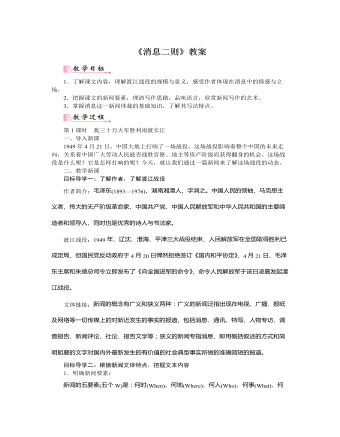
部编版语文八年级上册《消息二则》教案
结果:突破长江防线,占领南岸广大地区。目标导学二:细读课文,深层探究本篇报道的主体是写三路大军渡江战斗的经过,为何从中路写起?何处详写?何处略写?为什么这样安排?明确:中路于二十日首先渡江,所以先写。二十一日夜即已渡完,只用一句话就交代清楚了。至于其受阻情况,因与西路一样,敌人“纷纷溃退,毫无斗志”,所以此路略写。次写西路,详写。最后写东路,详写。由于这里敌人的防线比较巩固,加之此处敌军抵抗较为顽强,更重要的是这一地区战略意义重大,直接关系到能否包围敌军、解放南京,因此报道写得十分具体。尤其是最后两句详写了我军的战果,是为了说明水路长江和陆路镇江、无锡段铁路线已经全部被我军切断,敌人毫无退路,敌我双方态势已十分明显。
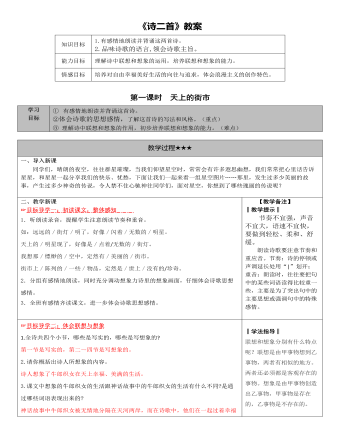
部编版语文七年级上册《诗二首》教案
目标导学三:品味语言,拓展延伸 1.第一节的运用了什么修辞?有何好处? 运用了比喻的修辞。前两句的比喻,本体是“街灯”,喻体是“明星”;后两句比喻的本体是“明星”喻体是“街灯”。这是一种回环往复的比喻,读起来特别的美,而内容上又从地上联想到了天上。这两个比喻构成了从地上写到天上的桥梁或天梯,写得天衣无缝,不露痕迹,非常自然。 2.后面三节,用了四个“定然”,一个“定”,有什么作用? 诗中的“定然”“定”表现的明明是想象的内容,却用断定的语气加以肯定,表明作者坚信,这样的理想世界是存在的,他对美好的未来充满信心,使读者受到感染和鼓舞。 3.“不信,请看那朵流星”中“朵”可不可以换成“颗”?“朵”用来作流星的量词,而不用“颗”,写出了流星的美,就像花儿一样。与牛郎织女的美好生活相映成趣。
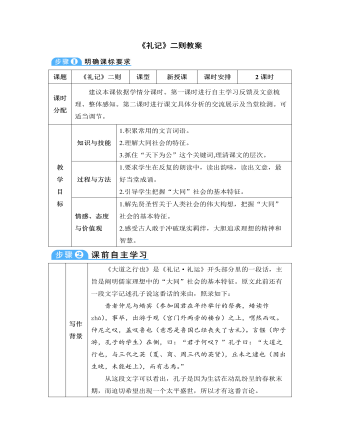
部编版语文八年级下册《礼记》二则教案
【课堂讨论,拓展延伸】1.文中“大同”社会跟陶渊明描绘的那个“世外桃源”有没有相似的地方?2.请说一段话描绘你心目中的理想社会。这是两道开放性的题目。第一题,要启发学生透过“桃源”中的生活现象来认识这个社会,例如从“黄发垂髫,并怡然自乐”中可以看出“桃源”中的老人和孩子生活极其幸福、快乐,这就是“大同”社会中“老有所终”“幼有所长”,由此还可以推知矜、寡、孤、独、废疾者这五种人同样受到全社会的关爱。第二题重在激发学生进行大胆新奇的联想和想象,营造一种畅游理想未来的热烈气氛。【把握文章主旨】仔细阅读课文,理解文章主旨。《虽有嘉肴》:本文论述了教与学的关系问题,说明了教和学是相辅相成的,是互相促进的道理。《大道之行也》:本文通过对理想中的社会特征的描述,阐明了儒家理想中的“大同”社会的基本特征,表达了作者对这个理想社会的向往,同时,也反映了我国古代劳动人民对美好生活的追求。
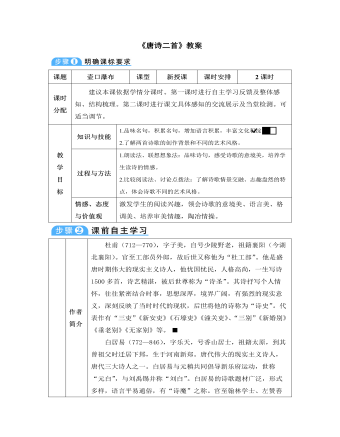
部编版语文八年级下册《唐诗二首》教案
761年8月,成都平原风雨成灾。草堂被吹破了,草堂前的一棵200年的楠树也被拔倒了。〖JP3就在诗人政治上受到冷遇,又加风雨成灾的情况下,杜甫写了《茅屋为秋风所破歌》。〖JP《卖炭翁》:本诗选自《白居易集》卷四(中华书局1979年版)。本诗是白居易《新乐府》组诗中的第三十二首,自注云:“《卖炭翁》,苦宫市也。”白居易写作《新乐府》是在元和(唐宪宗年号,806—820)初年,这正是宫市为害最深的时候。他对宫市十分的了解,又对人民有深切的同情,所以才能写出这首感人至深的《卖炭翁》来。皇宫所需的物品,本来由官吏采买。中唐时期,宦官专权,横行无忌,连这种采购权也抓了过去,常有数十百人分布在长安东西两市及热闹街坊,以低价强购货物,甚至不给分文,还勒索“进奉”的“门户钱”及“脚价钱”。名为“宫市”,实际是一种公开的掠夺。诗人有感于此,写下本诗。
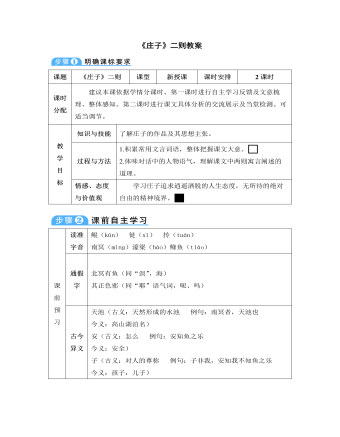
部编版语文八年级下册《庄子》二则教案
【再读课文,梳理结构】1. 文章标题为“北冥有鱼”,后来怎么又写鸟了?鸟是由鱼变化而来的。鲲的体形有几千里,变成鸟后,鸟的脊背不知有几千里长。说明庄子想象力丰富。2. 鸟为什么要迁徙到南冥?南冥是天人的大池,是鸟心目中的理想境地,是要追求一种精神的自由。3. 鲲鹏由北海飞到南海,需要借助什么条件?“海运则将徙于南冥”“抟扶摇而上者九万里,去以六月息者也”4. 句子赏析:“鹏之徙于南冥也,水击三千里,抟扶摇而上者九万里。”词句运用丰富的想象,奇特的夸张,描写了鲲鹏振翼拍水,盘旋飞向九万里高空的形象,这一形象能激发人的豪情壮志,具有强烈的艺术感染力。“击”“抟”等字传神、生动,让人产生丰富的想象和联想。
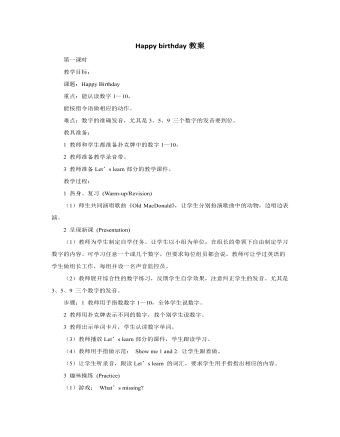
人教版新课标PEP小学英语三年级上册Happy birthday教案
(2)猜猜看每次请一个同学在黑板上画一种刚学到的物品,他每画一笔,就请班上的同学用英语猜他画的是什么。如猜得正确,就请下一位同学再重新开始画另一种物品。(3)Let’s rhyme.将所学的单词替换第一单元的Let’s chant中的文具。教师将全班分为两大组,教师举图片提示,如第一组说:I have a balloon.第二组一起说:Me too. 拍手,举第二幅图时两组交换。以此类推。(4)教师将单词的图片先面朝上贴在黑板上,给学生20秒时间记住这些单词,然后每张图卡用1张彩色纸盖上。学生要先说出彩色纸的颜色,再说出下面卡上的词。待学生熟悉后,可加大游戏难度,将盖着彩色纸的图卡在(黑板上)打乱,进行游戏。(5)让学生听录音,边说边做Let’s do部分的活动。(6)教师将Let’s do中的图卡打乱顺序,贴在黑板上,教师说一个指令,请学生指出正确的图片。正确的可为本组赢一分。
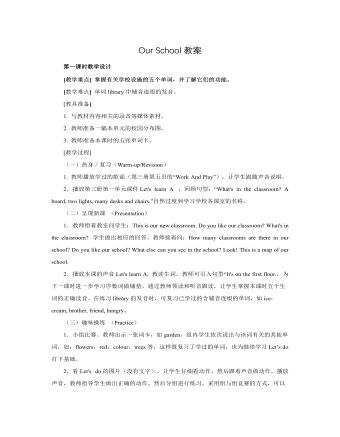
人教版新课标PEP小学英语四年级下册Our School教案
教学重点:Read and write 中的四个四会单词以及问句“Is this a teacher’s desk?”及其答句“Yes, it is.”在四线格中的正确书写。教学难点:拼读单词picture,在四线格中书写句型“Is this a …?”以及总结元音字母a的发音规则。教具准备:1.与教材内容相关的课件、声音、图片等媒体素材。2.教师准备相关的词卡。3.学生准备白纸和彩笔。教学过程(35sk. c om整理):(一)热身/复习(Warm-up/Revision)1.师生合唱该单元的歌曲和歌谣,边歌边舞。2.请学生表演Story time中的对话。3.猜谜语:教师给学生出一些简单的谜语,如:Jack is in a room. There are many books in it. He can see many students. They are reading books. They are quiet. Where is Jack?(二)呈现新课 (Presentation)1.请学生观察Read and write部分的情景图,预先空出来需要书写的四会单词,让学生独立思考,填充对话。

